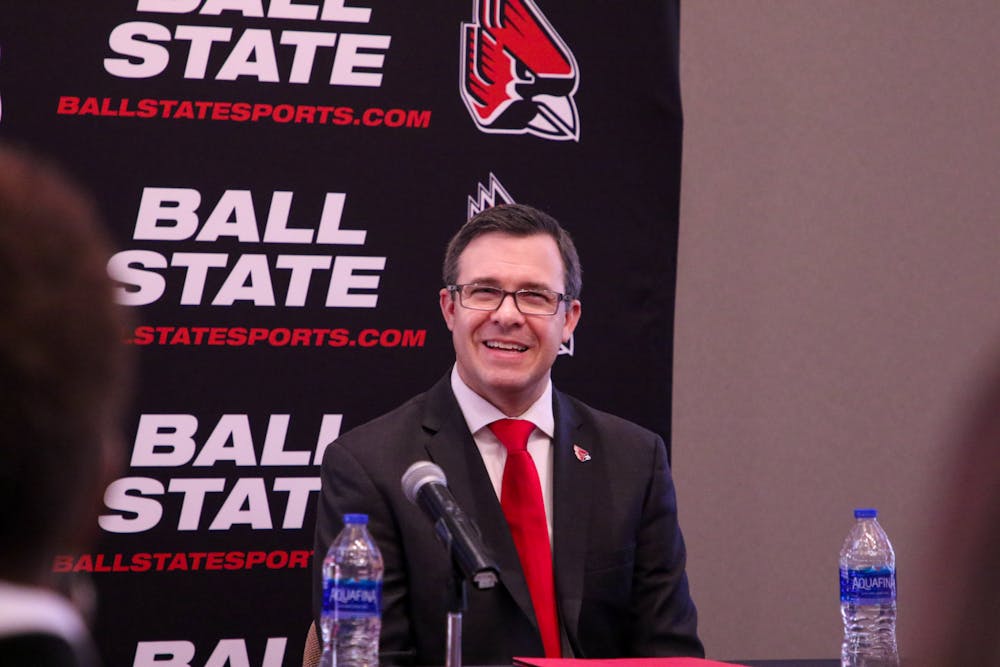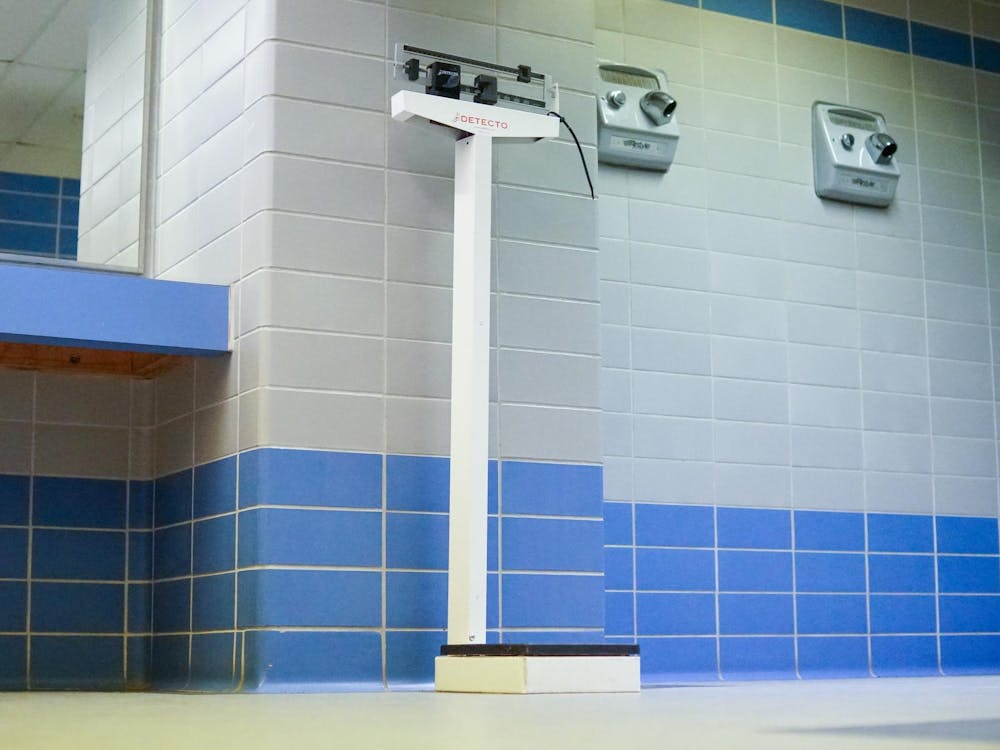The Ball State Daily News’ team of sports editors for the 2024-2025 school year — made up of lead editor Zach Carter and associate editors Adam Altobella and David Moore — met with Ball State director of athletics Jeff Mitchell Wednesday, May 8 to gain insight on the department’s recent performance and future vision.
Here are three takeaways from the meeting.
Ball State’s new hire touts ‘position of strength’ after year one
A collection of university officials and community members welcomed Mitchell as Ball State’s director of athletics at a news conference last February. A little more than a year removed from the warm reception, the experienced collegiate athletics administrator views his first full school year at the helm and his new university’s trajectory with satisfaction.
The department’s health is most clearly evidenced by its recent additions to the trophy case, he said. Though Mitchell did not claim to be the sole factor in this success, he asserted the gathering of eight Mid-American Conference (MAC) championships since his arrival speaks to where the department is positioned.
“I'm not suggesting that I take credit for that, but what I am suggesting is that we are in a position of strength, and we're continuing to thrive in a time in intercollegiate athletics where there is a lot of disruption,” Mitchell said.
The former deputy director of athletics at Southern Miss brought nearly two decades of experience into his new role, and he quickly applied his outside perspective to reinvigorate Ball State’s athletic department.
Aesthetic additions to Scheumann Stadium and a lighting project at Worthen Arena headline projects Mitchell and his team spearheaded during year one of his tenure, but some adjustments began even prior to securing the job. Most notably, researching the university ahead of the interview process led him to outline new positions to support the department’s overall capacity.
“I recognized that we had some gaps in how we can better support our student-athletes and our coaches,” Mitchell said. “We lacked some depth in certain places, and so I want to work to develop that.”
He carried out his preliminary plan by adding six newly created positions to the department’s administration staff. Associate athletic director for championship performance, held by former faculty member Lindsey Blom, is an example of one of these roles, and Mitchell said she and the other newly added pieces — like Mick Tidrow, who manages the department’s digital presence in a new full-time capacity — have enriched his team.
“[Blom] has been a brilliant hire for us because she understands how all those pieces work together,” Mitchell said.
Mitchell also filled a pair of head coaching vacancies for the softball and women’s tennis programs in year one. Helen Peña and Sachin Kirtane, respectively, earned those roles, and he said they each displayed the three qualities that will inform future Ball State coaching hires: expertise, the ability to connect with student-athletes and competitiveness.
In addition to managing the challenges posed by accepting a new professional role, Mitchell also grappled with adjusting to a new home over the last year. Though he jokingly admitted that previously living in Mississippi and California did not prepare him for Indiana’s frigid winters, he said his family has “really quite enjoyed it here.”
“I'm really proud of my wife April, my daughter Harper and my son Carson for being willing to make the move and for being excited about it,” Mitchell said.
Being ‘comfortable in the unknown’ with NIL
Over the last three years, the world of college sports has been changed by the rise of name, image and likeness (NIL). To Mitchell, the idea has become something its creators never intended it to be.
“Now we have these opportunities for the student-athletes to benefit from their name, image and likeness,” he said. “And then the whole system gets twisted on its head because boosters and donors want to use it as more of a recruiting tool.
“And then these collectives [are established] to pull in all this money and then all of a sudden, name, image and likeness almost goes by the wayside and there’s this concept of pay-for-play.”
With the sudden change and programs shifting their tactics to find ways to use NIL for items like recruiting, the landscape has changed drastically. This has forced Ball State athletics to look for ways to improve in the category. The Cardinals have their own collective – which donors run – called the ‘Feed the Bird Foundation.’
While he was openly cautious about NIL and everything that comes with it, the first-year athletic director understood to play the game, you have to be willing to look for those opportunities.
“I credit Ball State, before my arrival, for at least having the forethought of ‘hey, maybe we should get one of these collectives together,” Mitchell said. “The ‘Feed the Bird Foundation’ has certainly been beneficial in that space.”
Yet, Ball State athletics is not solely concerned with the movement. Things like improving facilities and adding new spaces for student-athletes are the program’s top priorities.
“Right now, I've got a certain number of goals, [and] not one of them is NIL-based,” Mitchell said. “That could change going into next year, but it just depends on what the landscape looks like.”
When Mitchell fundraises for the program, he understands NIL is something that will come up. He’s not shy about it but wants to make sure he gets his point across about other areas in the program.
Mitchell’s former boss at Santa Clara, Dan Coonan – who is now the commissioner of the ECAC – emphasized the challenges that athletic directors face with fundraising by saying he wanted to give himself a lobotomy after work.
“I always laughed when he would say that, but I think there's something to be said for controlling what you can,” Mitchell said. “I have opinions about it. [Ball State] President [Jeff] Mearns and I discuss it all the time.
“But at the end of the day, we don't necessarily get to dictate policy. So we have to be nimble [and] we have to be flexible as things do change.”
While his focus and viewpoints on NIL may change, there is one thing that will always stay consistent: the treatment of Ball State student-athletes.
“Whether we have a student for four years or for one season,” Mitchell said. “We're going to provide that student-athlete with a quality experience and hope to make a positive impact on his or her life.”
Mitchell is already looking at the future of Ball State athletics
As Mitchell’s first year at the helm of the Cardinals athletic program draws to a close, he has already begun setting the foundation for what the future holds for the department.
While still in the early stages, the Eric Foss Championship Performance Center gained approval from Ball State’s Board of Trustees on May 3, to begin the nearly $8 million construction project. A project of this magnitude requires much fundraising, and the entirety of the project is being funded through private gifts in which Eric Foss made the initial gift to get the project underway.
Though the process was long, Mitchell picked up where others left off and has turned those dreams into a reality.
“When I got here, I learned that there had been some preliminary conversations about it,” Mitchell said. “So what I wanted to do was pick up where it had been left and start playing with it and seeing if we couldn't make it a reality.”
For Mitchell, the goal of the facility is not just to enhance the student-athlete experience, but to make an impression on the athletic department in its entirety. With early projections being for the project to be complete in early 2026, the vision is already there for the impact he hopes it will have on future generations of not just student-athletes, but all Ball State students.
While it may be an athletic facility, Mitchell hopes, as a whole, the representation of Ball State is what shines through the most with this project.
“It is a student-athlete facility, so our student-athletes will benefit from it,” he said. “But I do think it will be a vibrant building that will be aesthetically pleasing. That will demonstrate the level of excellence that Ball State University displays towards its students every day.”
In addition to the brand new Eric Foss Championship Performance Center, Mitchell also mentioned the potential of talks beginning to circulate about other projects to come down the line with the space freed from the Performance Center such as repurposing the old weight room among other facilities within Worthen Arena.
“There's some preliminary thoughts of transforming that space into a state-of-the-art sports medicine facility, and we have some locker room desires across our programs as well,” Mitchell said.
Whether it be large-scale projects or locker room renovations, the gears are churning within the athletic department to ensure its development. Mitchell has seemed to embrace the challenge of leading the athletic department and aims to exert his influence on the department as a whole throughout his tenure.
“The chance to impact the entirety of a department is very rare,” Mitchell said. “When you can impact the entirety of our student-athlete population, that’s a very significant opportunity.”
Contact Zach Carter with comments at zachary.carter@bsu.edu or on X @ZachCarter85.
Contact Adam Altobella with comments via email at aaltobella@bsu.edu or on X @AltobellaAdam.
Contact David Moore with comments at david.moore@bsu.edu or on X @gingninj63.





